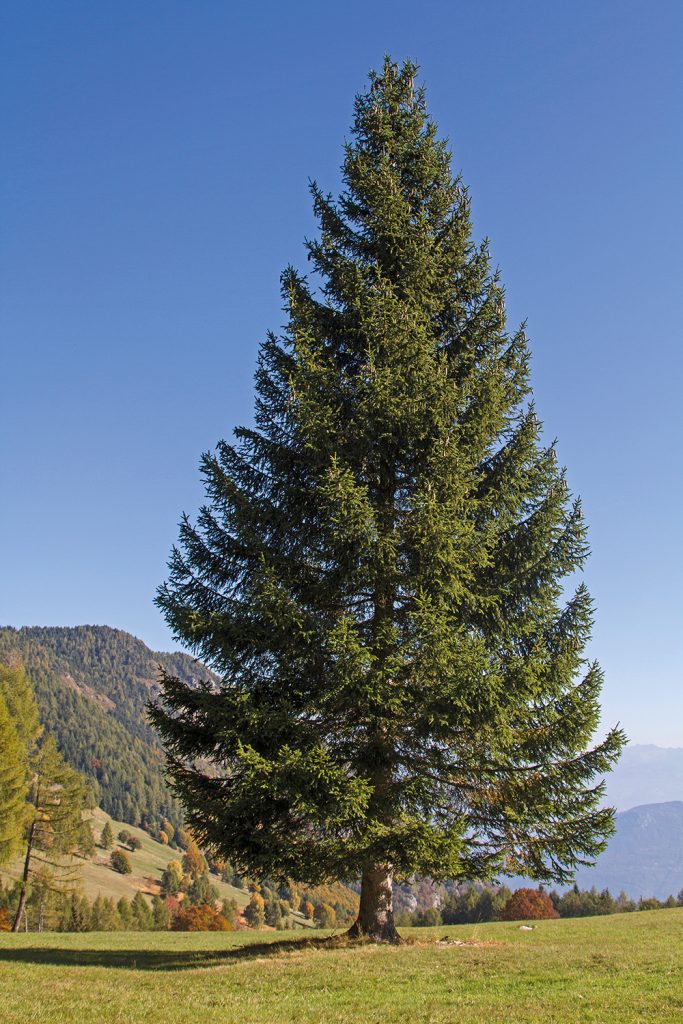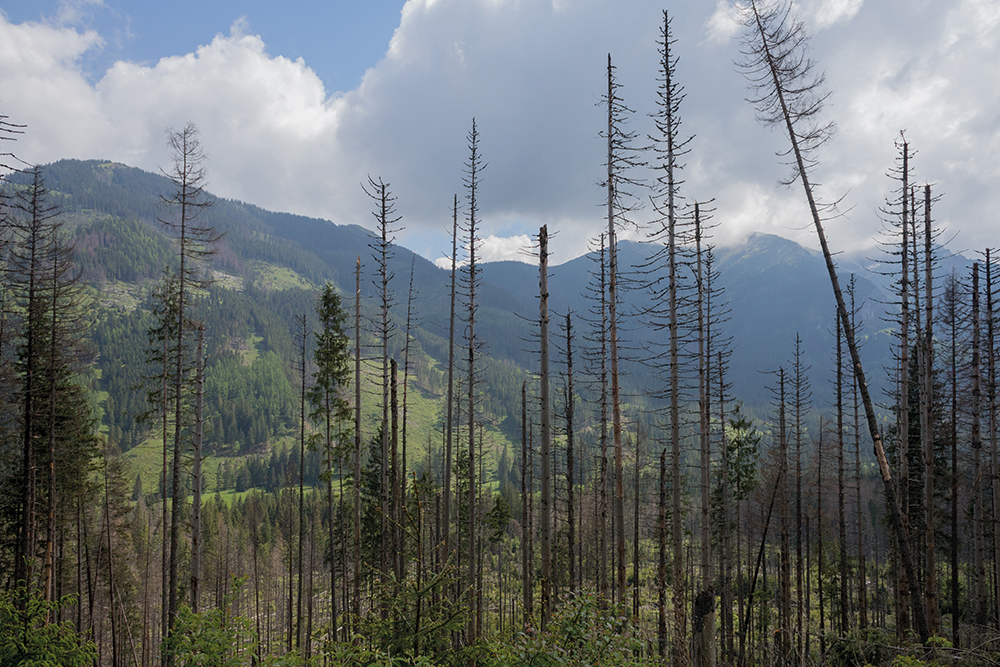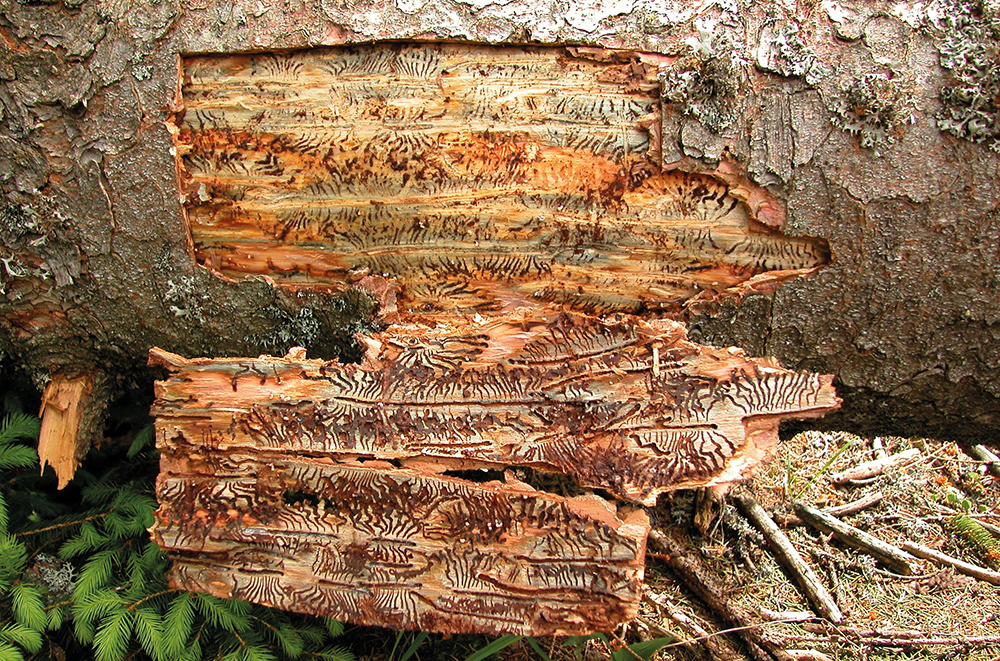Dr Sigrid Netherer – A Robust New Framework for Bark Beetle Management
The economically important Norway spruce tree naturally grows in mountain forest ecosystems, and is the main tree species in vast plantations across Europe. However, in the recent decades, its risk of attack by the destructive Eurasian spruce bark beetle has considerably increased. Although the complex interactions of host, pest and environmental conditions that allow attacks to occur have been extensively studied for more than 100 years, predictive tools for pest management still suffer from knowledge gaps. Dr Sigrid Netherer and her team at the University of Natural Resources and Life Sciences (BOKU), Austria, have been investigating the role of drought stress and other environmental and biotic factors on infestations, to produce a novel universal framework for monitoring and predicting bark beetle outbreaks.
Bark Beetles: A Hidden Threat
In its native range of northern and central Europe, the Norway spruce is of high ecological significance, providing shelter and food for countless woodland species. This tree species is also a vital source of wood for the timber and paper industries, making it one of the most economically important conifers in Europe.
However, the extensive Norway spruce forests are an ideal habitat for a small, but incredibly damaging, beetle called Ips typographus, or the Eurasian spruce bark beetle. This insect burrows through the bark of the tree and reproduces inside the living, nutrient-carrying tissues between the rough bark and the sapwood. The larvae eat their way through the phloem, pupate, and continue feeding as young adults, thereby killing off large trees.
Bark beetles are especially damaging for patches (or ‘stands’) of Norway spruce that are already stressed due to other factors, such as drought. With increasing annual spring and summer temperatures and rising incidence and severity of droughts due to the changing climate, the damaging effects of the spruce bark beetle are predicted to become exacerbated across Europe.
Controlling the pest population is incredibly difficult, because beetles spend much of their lifecycle hidden within the trees, and because spruce forests cover large areas and are less accessible in alpine regions. Identifying the physiological stressors that make individual trees and forest stands more susceptible to bark beetle attack, as well as understanding the unique pest-host interactions, is therefore imperative to developing an effective monitoring and control regime.
Dr Sigrid Netherer and her team in the Institute of Forest Entomology at the University of Natural Resources and Life Sciences (BOKU), Austria, have been investigating the interactions between the Norway spruce and the Eurasian bark beetle, with the aim of developing a risk model for use in the forestry industry. By identifying areas and times of high attack risk, due to the environmental stressors present in the area and swarming times of the beetles, forestry managers will be better equipped to monitor their trees and take preventative measures to avoid mass infestations.
Additionally, Dr Netherer and her team have been working towards understanding the mechanisms underlying natural tree defences, and in what circumstances these fail to be effective against bark beetle attack. Harnessing or promoting natural defences may provide novel strategies for preventing bark beetle infestations and associated economic losses.

Drought Hinders Tree Defences
The forestry industry is unusual because, unlike like other agricultural crops, trees are grown and harvested across timescales of decades rather than months. This also means that trees are vulnerable to environmental stressors over much longer periods; harvesting early due to damage or death has the potential to cause huge economic losses across multiple years.
Norway spruce trees are subject to a range of environmental stressors, such as storms and droughts, which make them more vulnerable to attack by biotic agents such as pathogenic fungi and insect pests. With extreme weather events predicted to increase in the future, attacks by the Eurasian spruce bark beetle are likely to become a much more frequent occurrence.
Drought stress, in particular, makes Norway spruce trees more susceptible to bark beetle attack, but a full understanding of the mechanisms behind this have been elusive. Dr Netherer and her team have been investigating the effects of drought-stress on spruce tree susceptibility to bark beetle attack in a comprehensive, water-manipulating field experiment. ‘The hypothetical background of my studies is that drought-stress limits photosynthesis and trees are thus provided with less energy for growth and defence of invading organisms,’ says Dr Netherer.
By artificially producing drought-stress in spruce trees by constructing rain-exclusion shelters, her team was able to monitor the physiological changes in the trees in response to water shortages. To prevent the loss of water, drought-stressed spruce trees close the apertures of their needles, the so-called stomata. However, this protective measure prevents the absorption of carbon dioxide from the air, which is required for photosynthesis – the production of sugars from sunlight, water and carbon dioxide.
Without this energy, trees have fewer resources available to devote to natural defence mechanisms, such as producing sticky resin and strong-smelling, carbon-based defence compounds that play a role in insect attraction and repellence. Dr Netherer demonstrated that drought-stressed trees were less able to resist attacks by both bark beetles and a fungus associated with the beetles that blocks water transport.
‘The hypothetical background of my studies is that drought-stress limits photosynthesis and trees are thus provided with less energy for growth and defence of invading organisms.’

Additional Factors Affecting Tree Susceptibility
By monitoring individual trees and whole Norway spruce stands using a soil-water-plant interaction model, Dr Netherer and her team determined water shortage thresholds at which trees become more vulnerable to attack by bark beetles. However, in these natural systems, trees are also affected by other environmental factors, such as elevation above sea level, wind speeds and storms, and the age and density of the surrounding trees.
By including Norway spruce forests from across a large area in Austria and across multiple years, the researchers were able to take all these additional factors into consideration. ‘We found that a combination of ample host availability, favourable temperature conditions for bark beetle development, and disposition of trees to attack caused by acute drought stress can intensify population growth and most likely lead to bark beetle mass outbreaks,’ explains Dr Netherer.
However, her team found that the relationship between drought stress and natural defences is not straightforward. Although even small levels of water shortages made some trees more vulnerable to attack by bark beetles, forest stands that were chronically water deficient – those that grew over longer periods with less water available to them – were less susceptible to attack.
This conundrum could be solved by considering how the trees allocate their resources. The researchers presume that in trees accustomed to growing in water-deficient areas, more energy is allocated to producing defences, which await on stand-by for invaders. Meanwhile, in trees that grow in areas that usually receive an ample supply of water, more energy is likely devoted to faster growth than to a reserve of defences.
‘Long-term but moderate drought stress has been hypothesised to increase tree resistance to insects as more energy resources are invested in the synthesis of defensive, secondary metabolites,’ explains Dr Netherer. ‘The bark beetle in fact prefers vigorously growing trees that suffer from sudden drought stress.’

A Predictive Framework
Some of the difficulty in predicting mass outbreaks of bark beetle infestations is understanding how the behaviour and lifecycle of the beetle interacts with the patterns of tree vulnerability. Dr Netherer and her team identified two distinct periods of potential attack – spring and summer – during their rain-exclusion investigations, and suggest that two or even three bark beetle generations each season may be emerging, due to the higher spring and summer temperatures. While bark beetles seem more attracted to healthy trees, the reduced defence of stressed trees is a key driver behind the destructive mass outbreaks, as beetles are hindered from boring into well-defended trees by resin exudation.
Additionally, the team points out that infestations in one area greatly increase the likelihood of mass outbreaks in other nearby plantations. ‘Favourable environmental conditions further trigger mass propagation of beetles, promoting fast and repeated attack of new trees within one season, and thereby posing a challenge to forest managers in the timely detection and removal of infested timber,’ says Dr Netherer. Thus, for a predictive model to be an effective tool for forest managers, it needs to include the dynamics of the bark beetle life cycle.
Dr Netherer and her team have therefore combined a model of the bark beetle life cycle, including annual periods of flight and reproduction, with their model on drought-stress thresholds and factors increasing tree vulnerability, to produce a novel universal framework for monitoring and predicting mass outbreaks of the Eurasian spruce bark beetle.
‘Capable of delivering robust, real-time simulations of potential bark beetle development and forest drought stress status, the tool could help forest managers to improve the appraisal of infestation risk in their Norway spruce stands,’ says Dr Netherer. ‘Such monitoring can strongly support forest managers in the prioritisation and scheduling of pest control measures with particular regard to detection of susceptible patches and timely removal of infested trees.’
With increasing temperatures enhancing the reproduction in bark beetle populations, and increasing incidence and severity of droughts reducing natural tree defences, refining pest management systems for Norway spruce forests is essential. Additionally, frameworks such as these provide a solid basis for developing models for other pest-host interactions in forest systems, which may prove to be vital as new threats arise in the future. Dr Netherer and her team have identified key areas for continued research, which include putting their universal framework to the test against previous and future mass infestation records.
Reference
https://doi.org/10.33548/SCIENTIA448
Meet the researcher

Dr Sigrid Netherer
Institute of Forest Entomology, Forest Pathology and Forest Protection
Department of Forest and Soil Sciences
University of Natural Resources and Life Sciences
Vienna
Austria
Dr Sigrid Netherer earned her PhD from the Institute of Forest Entomology at the University of Natural Resources and Life Sciences (BOKU), Austria, where she subsequently completed post-doctoral research investigating integrated pest management of the pine processionary moth, and where she currently holds an Elise Richter research fellowship from the Austrian Science Fund (FWF). Her research interests include forest entomology, and in particular, risk assessment and management of pests in forestry systems, and the effects of climate change and drought incidence on pest occurrence. She has also previously shared her expertise through provision of forest management plans, consultations on the economic values and damages in forestry systems, and environmental education and engagement with school children in the community.
CONTACT
W: https://forschung.boku.ac.at/fis/suchen.person_uebersicht?sprache_in=en&menue_id_in=101&id_in=5004
KEY COLLABORATORS
Dr Maria Rosa Paiva, Dr Eduardo Mateus, Universidade NOVA de Lisboa, Portugal
Extemit-K research team, Faculty of Forestry and Wood Sciences, Czech University of Life Sciences, Prague
FUNDING
Austrian Science Fund (FWF)
Austrian Federal Forests
FURTHER READING
S Netherer, B Panassiti, J Pennerstorfer, B Matthews, Acute drought is an important driver of bark beetle infestation in Austrian Norway spruce stands, Frontiers in Forests and Global Change, 2019, 2, 39.
B Matthews, S Netherer, K Katzensteiner, J Pennerstorfer, E Blackwell, P Henschke, P Hietz, S Rosner, PE Jansson, H Schume, A Schopf, Transpiration deficits increase host susceptibility to bark beetle attack: Experimental observations and practical outcomes for Ips typographus hazard assessment, Agricultural and Forest Meteorology, 2018, 15, 69.
S Netherer, M Ehn, E Blackwell, T Kirisits, Defence reactions of mature Norway spruce (Picea abies) before and after inoculation of the blue-stain fungus Endoconidiophora polonica in a drought stress experiment, Lesnicky Casopis Forestry Journal, 2016, 62, 169.
S Netherer, B Matthews, K Katzensteiner, E Blackwell, P Henschke, P Hietz, J Pennerstorfer, S Rosner, S Kikuta, H Schume, A Schopf, Do water limiting conditions predispose Norway spruce to bark beetle attack?, New Phytologist, 2015, 205, 1128.
S Netherer, P Henschke, B Matthews, A Schopf, Modelling dynamic predisposition to attacks by the Eurasian spruce bark beetle (Ips typographus L. 1758): a drought-stress experiment (ROSALIA ROOF PROJECT), Mitteilungen der Deutschen Gesellschaft für allgemeine und angewandte Entomologie, 2014, 19, 93.

Creative Commons Licence
(CC BY 4.0)
This work is licensed under a Creative Commons Attribution 4.0 International License. 
What does this mean?
Share: You can copy and redistribute the material in any medium or format
Adapt: You can change, and build upon the material for any purpose, even commercially.
Credit: You must give appropriate credit, provide a link to the license, and indicate if changes were made.
More articles you may like
Improving the Immune Response with Intraoperative Cell Salvage
Undergoing surgery comes with many risks. Numerous factors can influence the outcome, from the choice of anaesthesia to the type of operation. Long and complex procedures can require blood transfusions, which introduce yet another risk factor to the mix. Dr Michelle Roets from the Royal Brisbane and Women’s Hospital in Queensland seeks to help mitigate these risks through intraoperative cell salvage, a different type of blood transfusion which could revolutionise surgical outcomes.
Professor Mark Pagel | Evolution’s Gradual Path: New Model Reveals How Mammals Changed Over Time
A groundbreaking statistical model developed by Professor Mark Pagel and colleagues at the University of Reading demonstrates that even dramatic evolutionary changes in mammals can be explained through gradual Darwinian processes, resolving a long-standing puzzle in evolutionary biology and challenging our understanding of how species change over time.
Professor Edward Smith | Soaring to New Heights: Investigating the Aeroelastic Stability of Composite Aircraft Wings
Combining the best aspects of helicopters and fixed-wing aircraft into a single vehicle has been a long-held ambition in the aerospace industry. From Leonardo da Vinci’s early drawings of an ‘aerial screw’ to the V-22 Osprey tiltrotor aircraft used by the U.S. military today, engineers have grappled with the challenge of creating aircraft capable of both vertical take-off and landing (VTOL) and high-speed forward flight. While helicopters offer unparalleled VTOL performance, their top speeds are limited to around 300 km/h. Fixed-wing aircraft offer greater speed but require long runways for take-off and landing. Reconciling these conflicting design requirements is a major challenge.
Enabling Systems Engineering in an Unsupportive Environment
In an ideal world, systems engineers would work in organisations that fully embrace and support best practices in their field. However, the reality is often quite different, with many engineers finding themselves in environments that are unsupportive or even hostile to effective systems engineering practices. Eileen Arnold and Dorothy McKinney, two experienced systems engineers, have devoted their careers to helping fellow engineers navigate these challenging situations and make a positive impact despite organisational obstacles. Their insights and strategies provide a roadmap for success in even the most difficult circumstances.




